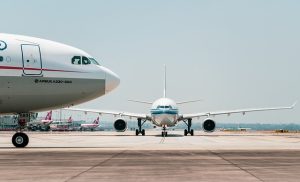
Airplanes are often categorized based on their purpose. There are passenger airplanes and cargo airplanes, for instance. While they both feature many of the same parts — fuselage, wings, tail assembly, landing gear, engines, etc. — they aren’t the same. Passenger airplanes and cargo airplanes are used for different purposes.
What Is a Passenger Airplane?
A passenger airplane is a type of aircraft that’s designed primarily to transport people. Some passenger airplanes may only accommodate a half-dozen passengers, whereas others may accommodate hundreds of passengers. The Airbus A380 can seat up to 853 passengers, making it the largest passenger airplane in the world.
What Is a Cargo Airplane?
A cargo airplane is a type of aircraft that’s designed primarily to transport goods and objects. The weight limit of a cargo airplane varies depending on many factors, one of which is the size. Large cargo airplanes, though, can typically carry 50 to 100 tons. Smaller cargo airplanes have a lower weight limit. Regardless, all cargo airplanes are used primarily to transport goods and objects.
Key Differences Between Passenger and Cargo Airplanes
The primary difference between passenger and cargo airplanes is that the former are designed primarily to transport people, whereas the latter are designed primarily to transport goods and objects.
Because they have different purposes, passenger and cargo airplanes are built differently. They still feature many of the same parts, but passenger airplanes typically have rows of seats in the fuselage. Cargo airplanes, on the other hand, feature a more open fuselage interior. Many cargo airplanes have built-in rollers in the fuselage to streamline the process of loading and unloading goods.
Passenger airplanes feature “classes” of seats, such as economy, business and first class. Economy seats are the cheapest but offer the least amount of leg space. First-class seats are the most expensive, but they offer the greatest amount of leg space.
Another key difference between passenger and cargo airplanes involves windows. Passenger airplanes typically feature more windows than their cargo counterparts. Each row of seats has its own set of windows so that passengers can look out of the airplane. Cargo airplanes have fewer windows, with many of them only having windows in the cockpit and not the fuselage.
Doors are another key distinction between passenger and cargo airplanes. Passenger airplanes are designed with multiple doors for boarding and exiting as well as emergency evacuation. Cargo airplanes have fewer doors.
In Conclusion
Passenger airplanes can still carry objects, and cargo airplanes can still carry passengers. Passenger airplanes are simply designed primarily to transport passengers, whereas cargo airplanes are designed primarily to transport goods and objects.



